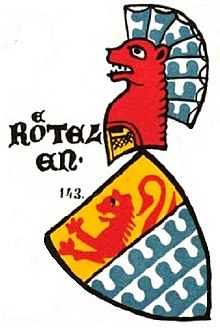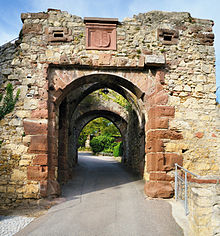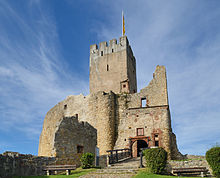Rötteln Castle
[3] In 1444, the domain of Badenweiler passed from the last Count of Freiburg, John, to the son of Margrave Wilhelm, Rudolf IV von Hachberg-Sausenberg.In May 1633 Imperial forces led by Ernesto Montecuccoli took possession of the castle, which belonged to the Protestant Frederick V of Baden-Durlach an allie of the Swedish King Gustavus Adolphus of Sweden.[5] Right after the Battle of Rheinfelden in March 1638 the French-allied mercenary army led by Bernhard of Saxe-Weimar conquered the castle[6] whereby causing severe damages.The Franco-Dutch War (1672–1678) affected the Breisgau-region in the last phase when François de Créquy a Marshall of the French King Louis XIV conquered Freiburg im Breisgau at the end of 1677.Based on the fortifications of Freiburg and Breisach Créquy raided this region in the following year and tried to take over the fortified city of Rheinfelden.On the road to Rheinfelden a detachment of his army attacked Rötteln by using kartouwen and the Imperial garrison surrendered after a short time on June 29, 1678.The stones were used by the French to build their fortress at Huningue (on the left bank of the river Rhein just before the city of Basel).The apex of the portal contains a slab with the coat of arms of the builder-owner, Marquis Rudolf IV of Hachberg-Sausenberg (today just a copy).The overall picture of the outer bailey was characterized by facilities for the main functions of the place - agriculture, administration and military garrison.The farmstead, storage buildings, and lodgings for maids, servants, craftsmen and their families made a fortified village out of the outer bailey.In addition to the main gate, the narrow manhole (today closed by a fence) grants access to individuals.Above the apex of the main gate there is a sandstone slab sculpted with the coat of arms of the builders and powerful owners of the castle—the Margraves of Hachberg-Sausenberg.In the second half of the 14th century, Margrave Rudolf III carried out major reconstruction work on the manor house.At times, it also served as a prison tower; inside, parts of jougs (iron collar), footcuffs, handcuffs, and stone weights have been found.The new building was comfortable: there were numerous smaller rooms that were heated with cocklestoves and toilet facilities on the eastern exterior wall.The chapel of St. Mary (consecrated 1504) on the north side of the bailey was an elongated hall with two columns in the center axis that supported a ribbed vaulting in late Gothic style.Its construction dates back to the early days of the castle among the free nobles of Rötteln but may be older.Along with the curtain wall and the neck ditch, the Bergfried formed the most important element in the defense system of the upper castle.On the lower layers, the stone construction is remarkable and is found only in Romanesque churches of the area but for castles it is unique in the region of Baden.The top of the Bergfried allows for a view of the whole castle, into the valley of the river Wiese, to the Black Forest, to the Swiss Jura and the Alsatian Vosges mountain range, and sometimes even the Bernese Alps.Pilgrim Hans von Waltheim [de] from Halle an der Saale,[9] having visited the castle on July 9, 1474, marvelled at the tapestries in the cabinet and said that they had the most beautiful workmanship of pictures, of countenance, of clothing, of animals and flowers and other work, as if they lived.[11] Additional evidence of the sophisticated inventory can be seen in the stove tiles which are exhibited in the castle's museum and the Dreiländermuseum [de] in Lörrach.These include tiles, glassware, fragments of tableware, tools, parts of weapons, pipes, a chessman,[15] a judge's table along with an executioner's sword[16] and different instruments of torture.[22] Since 1968, the society Burgfestspiele Rötteln performs classic plays on the outdoor stage in the outer bailey every year.









LörrachBaden-WürttembergLords of Rötteln11th centuryThirty Years WarFranco-Dutch War1356 Basel earthquakeGermankilometresHouse of RöttelnRöttelnbailiffWiese valleyKonstanzSchopfheimMarkgräflerlandRudolf I of Hachberg-SausenbergMargrave of Hachberg-SausenbergMargraveSausenburg CastleMargrave Rudolf IImayor of BaselBasel earthquake of 1356BadenweilerMargrave WilhelmRudolf IV von Hachberg-SausenbergPhilip the GoodBurgundyPhilip of Hachberg-SausenbergBreisgauMargrave of BadenGerman Peasants' WarImperialErnesto MontecuccoliProtestantFrederick V of Baden-DurlachSwedishGustavus Adolphus of SwedenHerman FortunatusHouse of BadenOtto Louis of Salm-Kyrburg-MörchingenBattle of Nördlingen (1634)Battle of RheinfeldenmercenaryBernhard of Saxe-WeimarFrançois de CréquyLouis XIVFreiburg im BreisgauRheinfeldenkartouwenscorched-earthSchwarzwaldvereinbastioncourt of appealsMargraves of BadenredoubtHuninguecurtain wallouter baileydrawbridgebarrel vaultfootcuffshandcuffswater tableembrasureBurgundianscocklestovesBergfriedneck ditchRomanesque churchesBlack ForestSwiss JuraVosgesBernese AlpsHalle an der Saaletapestriescabinetstove tilesRomandyround shotsexecutioner's swordinstruments of torturetavernfortificationBurgfestspiele Röttelnopen-airconservation areaList of castles in Baden-WürttembergSWR FernsehenWayback MachineSüdkurierprotected landscapeDeutscher KunstverlagEntenstein CastleInzlingen CastleWasserschloss Steinen